Make Art, Not War
Political posters can contribute enormously to street demonstrations that will inevitably increase in both number and intensity.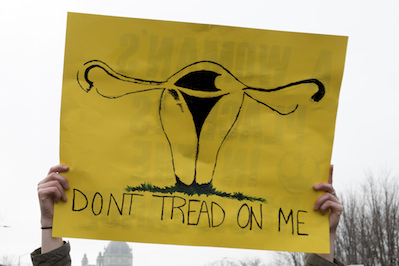
A protest sign at the Jan. 21 Women’s March in St. Paul, Minn. (Fibonnaci Blue / CC BY-SA 2.0)
“Make Art Not War: Political Protest Posters from the Twentieth Century”
A book edited by Ralph Young
Political posters have intrigued and delighted me, both as an activist and as a teacher, for most of my adult life. My deep affection for this powerful artistic medium began in France in May 1968, when I happened to be in Paris following my university days. I took a small part in the massive demonstrations there, where posters were an integral part of the historic agitation. Images of brutal gendarmes, caricatures of Charles de Gaulle, attacks on bureaucracy, demands for free expression and many more radical themes all reflected brilliant design and powerful political criticism. Created daily by students and striking workers, these posters were central to the French rebellion and to 20th century art history.
 Make Art Not War: Political Protest Posters from the Twentieth Century
Purchase in the Truthdig Bazaar
Make Art Not War: Political Protest Posters from the Twentieth Century
Purchase in the Truthdig BazaarPosters are both works of art and notices to the public. Intended for mass reproduction, they combine verbal messages with visual elements designed to attract viewers and solidify their commitment to the cause. Their effectiveness depends on efficient, inexpensive reproduction that will swiftly disseminate the work’s major theme or message. They performed this role in Paris in 1968 and have done so before and since.
Historian Ralph Young has presented a valuable collection of 20th century American political posters from the Tamiment Library and Robert F. Wagner Labor Archives Poster and Broadside Collection of New York University. This collection contains over 2,900 posters from 1904 to the present, and addresses the rich tradition of social protest throughout that period. Professor Young’s selection is a useful historical and thematic cross section. Many of the examples are visually engaging and reveal the remarkable fusion of technical excellence and social criticism that highlight posters as a major feature of political art. Others are particularly significant because they encourage viewers to discover, through the posters, powerful features of international and American history that are rarely taught in educational institutions at all levels.
Young is a longtime scholar of political dissent at Temple University. His anthology of articles, speeches, songs, sermons and letters, “Dissent in America,” is an outstanding compendium of primary source materials on social protest. In the present work, he provides an essay contextualizing political posters in the broader tradition of American political dissent. His essay shows how this vital visual art form has been an indispensible feature of the various struggles in America to build a society that provides dignified lives to its workers; its women; its racial, ethnic, and sexual minorities; and its citizens opposing several immoral and illegal wars from Vietnam to the present.
“Make Art Not War” is a pictorial volume, and Young’s essay is not intended to be comprehensive. It serves its limited purpose effectively, however, allowing readers to understand American political posters in the broad historical framework that gives rise to all cultural expression that supports movements for social change and transformation. The volume also offers a brief description of the Tamiment Collection, a remarkable resource for researchers interested in visual social protest. That resource is only one of many in the U.S. Many museums have substantial political poster holdings, and one of the premier political poster institutions is the Center for the Study of Political Graphics in Los Angeles, which has over 85,000 posters, including 2,600 online.
General audiences can enjoy the diverse visual examples in this volume, especially those people who have participated in mass movements and who have affectionate regard for socially conscious art. Educators, especially in high schools and colleges and universities, can take special advantage of many of the posters. Some of the book’s early entries lend themselves especially well to imaginative pedagogical strategies.
READ, WATCH, LISTEN: A Revolutionary Art Form That Leads to Social Change
A 1949 election poster from New York’s American Labor Party, for example, proclaims “Make Marcantonio Mayor.” That provides a powerful opportunity to explain that for more than 20 years, a viable leftist political party existed and had some significant political successes. Among its key figures was Vito Marcantonio, one of the few genuine radicals to serve for an extended period as an elected official in the United States. The presence of this poster in the volume modestly counters the unfortunate reputational censorship that Marcantonio has suffered in the wake of Cold War anti-communism.
Likewise, the book features a 1955 poster entitled “Vote and Unite” that the Communist Party disseminated in Pittsburgh announcing a speech by Elizabeth Gurley Flynn. In almost a half century of university teaching, I cannot recall any student who recognized her name, even though I have mentioned her and her contributions in various classes. Flynn was a founding member of the industrial Workers of the World, the original “Rebel Girl.” A lifelong socialist, feminist, labor organizer and overall giant figure of American radical history, her legacy demands respect. This poster can mobilize curiosity about her, the IWW and the still lesser known story of women in the struggles for social justice.
The crown jewel of this volume is Ben Shahn’s “This is Nazi Brutality.” Shahn was one of the finest political artists in American and world art history. This remarkable poster was a protest against one of the most horrific Nazi atrocities during World War II. After the Czech resistance assassinated Reinhard Heydrich in 1942, the Nazis obliterated the entire Czech village of Lidice, killing all the men and boys and many women. The remaining women and children were sent to concentration camps. I have used this chilling artwork often to inform students of the depth of Nazi depravity — and to remind them that mass murder hardly ended with the German defeat in 1945.
The remaining posters in “Make Art Not War” address modern issues with unusual contemporary relevance. Most of the posters reflect engagement with past problems that still require redress in the early years of the 21st century. Strong feminist posters pervade the volume, showing the historical emergence of women in the 1960s and 1970s from centuries of subjugation in a patriarchal society. But ironically, some of the issues in these posters could — and should — be displayed in public settings today. For example, “Don’t call me a girl!” reveals the repressive power of language in gender relationships. Women are not girls, a lesson that many of my female and male undergraduates, even now in 2017, fail to comprehend. Another prominent ’70s feminist poster, “Jail The Rapist, Not The Victim,” is a reminder of the continuing specter of sexual assault. Recent high profile cases in the courts, where rapists have received trivial sentences from insensitive judges, only exacerbate the large-scale male indifference to sexual violence against women. Even now, many rape victims are still suspected or even accused of bringing on the attacks themselves. This poster too could be displayed on campuses, police stations and courthouses throughout the country.
This book also contains several posters advancing the African-American liberation struggle. Iconic figures including Martin Luther King, Malcolm X, Angela Davis and others join historic slogans like “One Man, One Vote” and “Power to the People” in reminding viewers of recent struggles for racial justice and dignity. Racial problems are also continuing, and at times they are even worse. Killings of young black men, racist incidents in neighborhoods and campuses, egregious restrictions against black voters, and continuing discrimination in many fields demand vigilance and political action, including relevant 21st century poster art.
Young has also included some posters highlighting the struggles of Native Americans. One eerily relevant poster from the ’70s is entitled “Our Land is more valuable than your money.” Part of a series of posters honoring such historic actions as the takeover of Alcatraz Island and the 1969 occupation of Wounded Knee, this effort could not have more obvious contemporary significance. The heroic and historic Standing Rock protests against the Dakota Pipeline, which may well resume in 2017, could easily employ this stunning artwork commending American Indian rights and dignity.
After the Stonewall Riots of 1969, the modern gay rights movement began, continuing to the present. Gay liberation and pride posters have been ubiquitous since then. Even with legal victories like same-sex marriage, however, homophobia remains rampant in America and LGBTQ people still face legal restrictions, widespread hostility and personal violence. Past and new posters addressing these issues are likewise necessary as the struggle continues.
Many of the posters included in the volume address international issues, especially opposition to the Vietnam and Gulf wars. These are vibrant examples of a theme that has pervaded poster art since Käthe Kollwitz drew her masterpiece “Never Again War” in 1924. Demonstrations against the war in Vietnam, the Gulf War, and the Iraq War regularly featured colorful posters that helped create solidarity among antiwar resisters. American military adventurism continues, requiring new antiwar posters regularly to reflect political sentiments and reinforce the collective will to resist.
A few of the posters in the collection are calls for specific actions, especially boycotts and divestment. A dramatic 1985 example from artist and archivist Lincoln Cushing is entitled “End Apartheid” and addresses the worldwide fight against the oppressive white racist regime in South Africa. One of several on this subject, the poster pictures a black man at the bottom of the African continent. But its subtitle has the most, if unintended, relevance for the present: “South Africa Must Be Free. Divest Now.” A change in the map, replacing a black African with a Palestinian, and substituting Israel for South Africa in the subtitle, would create an effective, if highly controversial, poster for the present.
Several other posters on related political issues round out this splendid compendium of visual social protest. As the United States, and the world, enters a new period of repression and danger with the Donald Trump regime, the need for cultural resistance in all forms — literature, theater, music, film, visual art and hybrid strategies — grows more acute. Artists who create political posters can contribute enormously to the organizational efforts and street demonstrations that will inevitably increase in both number and intensity.
These artists should look to the past for inspiration, including to this and other collections of valuable and effective political posters. Their collective efforts can add to the burgeoning body of political art that has served as the conscience of humanity for many centuries. But more important, their work must, above all, be equally judged by the successes of the causes themselves to which they have lent their creative energies.
Independent journalism is under threat and overshadowed by heavily funded mainstream media.
You can help level the playing field. Become a member.
Your tax-deductible contribution keeps us digging beneath the headlines to give you thought-provoking, investigative reporting and analysis that unearths what's really happening- without compromise.
Give today to support our courageous, independent journalists.
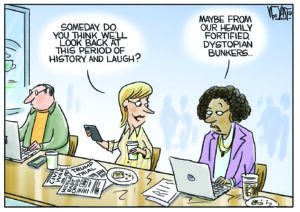


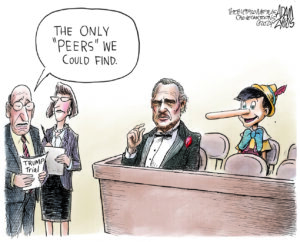
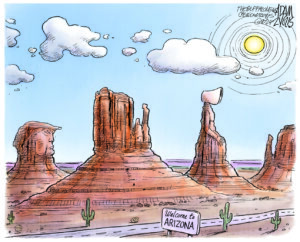
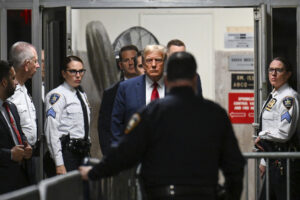
You need to be a supporter to comment.
There are currently no responses to this article.
Be the first to respond.